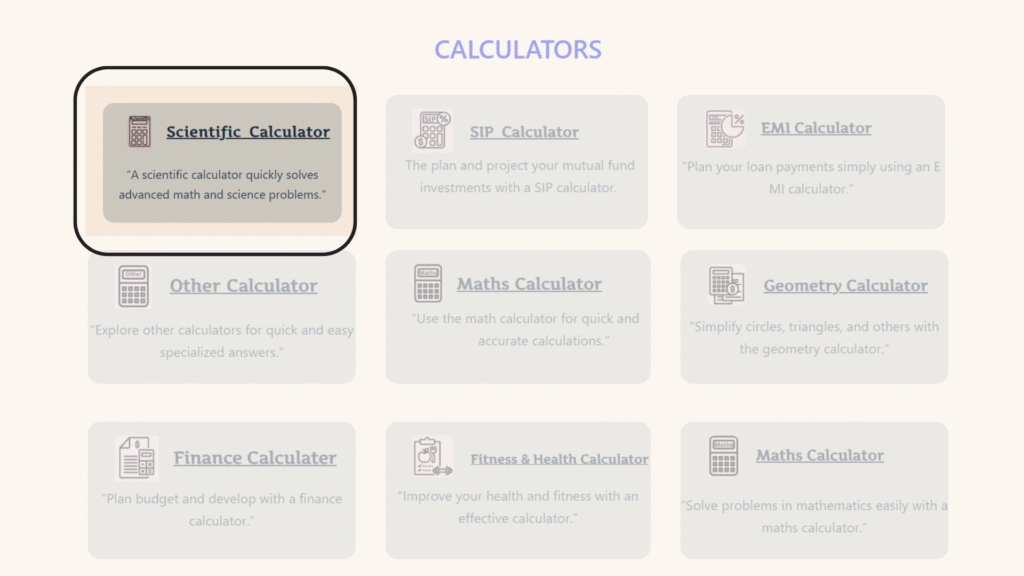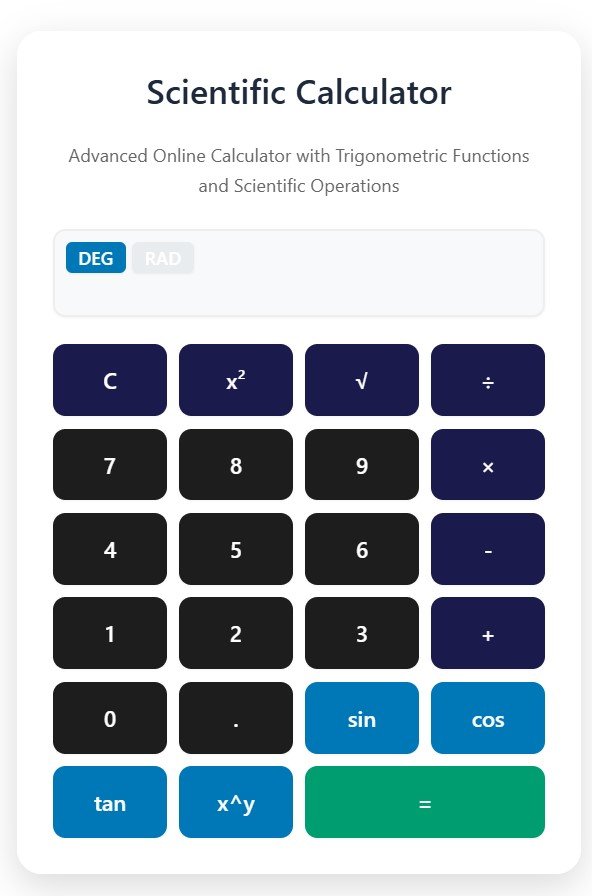Scientific Calculator
Advanced Online Calculator with Trigonometric Functions and Scientific Operations
Maths Solver
Key Features:
Modern gradient background with glass-morphism effect
Scientific functions (sin, cos, tan, square, square root)
Degree/Radian mode toggle
Power function (x^y)
Responsive design
Error handling
Interactive hover effects
Clear visual hierarchy
The Ultimate Guide to Scientific Calculators: Features, Uses, and Tips
What Is a Scientific Calculator?
A scientific calculator is an electric devices that can do difficult math operations, like mathematical, unstoppable, and trigonometry ones. Scientific calculators are designed to solve more complex math issues found in science, engineering, and mathematics, in contrast to basic calculators, which usually handle basic math.
Key Features of Scientific Calculators
1.Trigonometric Functions
Functions like sine (sin), cosine (cos), and tangent (tan), as well as their inverses, are available on this advanced tool. These are important to resolving issues in engineering, physics, and geometry.
2.Logarithmic and Exponential Functions
Functions such as natural logarithm (ln), common logarithm (log), and exponential (e^x) are important. These functions are widely used in fields like chemistry and biology.
3. Scientific Notation
This advanced tool can handle very large or small numbers by expressing them in scientific notation. This is particularly useful in physics and astronomy, where such numbers are common.
4. Fraction and Decimal Calculations
Many scientific calculators allow users to work with digits and fractions, showing the answers in either format. Both professionals and students working with different kinds of information can benefit from this variety.
5. Equation Solvers
This type of calculator come with built-in solvers for With integrated solvers for simple, quadratic, and polynomial formulas, simple, quadratic, and polynomial formulas, modern scientific calculators simplify the process of solving mathematics and engineering problems.


How to Use a Scientific Calculator Effectively
1. Familiarize Yourself with the Functions
Before using a scientific calculator, take time to understand the layout and functions. Most calculators have dedicated keys for trigonometric, logarithmic, and exponential functions.
2. Make sure the series of processes is correct by using commas.
Use commas to group variables when inputting complex expressions to guarantee that calculations are done correctly.
3. Utilize the Memory Functions
Scientific calculators often have memory registers to store intermediate results. This feature is helpful when performing multi-step calculations.
Applications of Scientific Calculators
1. Education
In educational settings, scientific calculators are used to teach and solve problems in mathematics, physics, and engineering. They help students understand complex concepts by providing a practical tool for calculations.
2. Professional Use
Professionals in fields like engineering, architecture, and data analysis depend on scientific calculators for tasks such as structural calculations, statistical analysis, and financial modeling.
3. Research
Researchers use scientific calculators to analyze data, perform statistical tests, and model complex systems in various scientific disciplines.

Conclusion
This type of calculator is an essential tool for anyone involved in advanced mathematical calculations. By understanding its features and functions, you can enhance your problem-solving skills and efficiency. Whether you’re a student, professional, or researcher, mastering the use of a scientific model can significantly help in your mathematical Plans.
Whether you’re working in a technological sector, studying physics, or solving math problems, having the right calculation tools can be quite beneficial. Accuracy and simplicity are two benefits of using modern gadgets meant for complex math. From logarithms to trigonometry, these tools facilitate a variety of academic and professional uses. Choosing a reliable model and mastering its application will prepare you for dealing with even the most difficult numerical problems. Check out our associated articles and resources for more informative tools and advice.
“With the right tools and a bit of practice, solving complex calculations becomes a much smoother experience.”



